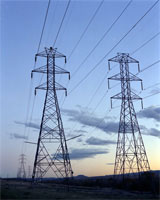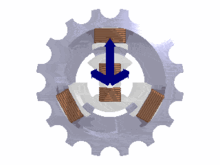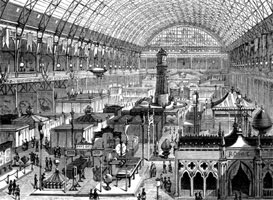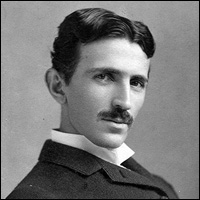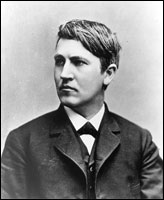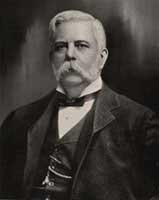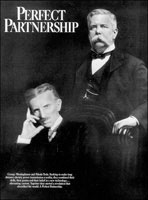Today, the entire world uses the 3 phase alternating current system invented by Nikola Tesla in 1881. After ferocious opposition from Thomas Edison and General Electric, George Westinghouse made Tesla's AC available to the entire world.
|
|
|
Since Tesla's AC system was introduced by George Westinghouse in 1886, little changes have been made to the generation and transmission of electricity. The frequency that Tesla recommended was 60 cycles per second and so 60 Hz is the standard frequency used in the United States. Tesla later tried to eliminate the unsightly wires, but his wireless transmission system was sabotaged by J. P. Morgan, and has never yet been implemented in any country.
Tesla's boss in Paris was Charles Batchelor the Briton!!
In 1881, Nikola Tesla had his EUREKA moment while walking in a park in Budapest, Hungary. At that time he saw a vision of a fully functioning alternating current (AC) electric induction motor.
In April 1882, Tesla moved to Paris, where he began working for the Continental Edison Company, designing and making improvements to DC electrical equipment. His boss there was a British textile industry employee named Charles Batchelor:
Formerly a resident of Manchester, England, Batchelor was a "master mechanic" who had been sent to America a decade earlier to present innovative thread making machinery research created by his employers, the Coates Thread Company. There he met Edison and shortly became his most trusted associate. (Seifer, Wizard: The Life and Times of Nikola Tesla, p. 28).
During Tesla's stay in Paris an important Electrical Exhibition was held to standardize the emerging electrical industry.
|
|
|
Batchelor wrote a glowing letter of introduction for Tesla to give to Edison. He also telegraphed Edison that Tesla was on his way and told him all about Tesla's revolutionary discovery.
|
|
Like Francis Cabot Lowell, Tesla had a photographic memory and everything was stored in his head. He went ahead and constructed the motor in Edison's laboratory. That was his fatal mistake in trusting Edison. Even before he arrived in the U.S., Tesla was a great admirer of Edison and had no reason to suspect that he was a British spy.
Edison already knew all about Tesla's remarkable discovery but his outward reaction was to deride Tesla and his AC motor:
When Tesla enthusiastically described his polyphase system and told Edison he believed alternating current was the only practical kind of current to use in a power-and-lighting system, Edison laughed. Edison was using direct current in his system. He told Tesla very bluntly that he was not interested in alternating current; there was no future in it and anyone who dabbled in that field was wasting his time; and besides, it was a deadly current whereas direct current was safe. Tesla did not yield any ground in the discussion–nor could he make any progress in his efforts to get Edison to listen to a presentation of his polyphase power system. On technical grounds, they were worlds apart. (O' Neill, Prodigal Genius: The Life of Nikola Tesla, p. 62).
After that conversation, Nikola Tesla should have walked out the door and never looked back. So enthralled was he by Edison's reputation as an "inventor" that he actually went to work for him.
Batchelor hurried back from Paris to New York to steal Tesla's revolutionary motor!!
After Tesla left Paris, Charles Batchelor soon followed him. To his amazement, Batchelor showed up just days after Tesla started working for Edison.
Tesla's first assignment for Edison was fixing 2 malfunctioning dynamos on the SS Oregen. Tesla fixed the dynamos in record time, and while returning from the ship, he met Edison and Batchelor exiting his laboratory:
Calling on members of the crew to assist him, Tesla worked through the night and by 4 A.M. had both machines running as well as the day they were newly installed. Walking back to the shop on lower Fifth Avenue at 5 A.M., in the dim early dawn he met a group of men just leaving. In it were Edison and Bachelor, who had just returned from Paris in the meantime, and several others who had finished their night's work and were returning to their homes. (O' Neill, Prodigal Genius: The Life of Nikola Tesla, p. 63).
The group of men who emerged by the dawn's early light included Edison's secretary named Samuel Insull. They were all studying Tesla's AC motor with wonder and fascination. What a pity that Tesla did not walk in unexpectedly and catch them red-handed. Bachelor did have the technical ability to duplicate the motor.
Tesla slaved for Edison for about 9 months for the measly salary of $18 a week. Edison kept him in his employ by promising him a $50,000 bonus. When Tesla asked for the bonus, Edison told him that he was only joking.
Tesla wanted the money for one reason: to develop his AC motor. Unfortunately, Tesla had nothing in writing, and being an Orthodox Christian, he believed that a man's word was his word....That was the reason he quit working for Edison in disgust.
Batchelor and Samuel Insull were soon off to London with Tesla's AC motor diagrams!!
The group of men who emerged from Edison's laboratory by the dawn's early light included Edison's secretary, Samuel Insull. While Edison was deriding Tesla and his AC motor, Batchelor and Insull were off to London with diagrams of the revolutionary invention.
|
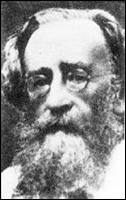 James Ludovic Lindsay (1847–1913). |
Lindsay was close friends with Sir Coutts Lindsay–the founder of the Grosvenor Gallery. When Lindsay returned from the Paris Electrical Exhibition, Coutts Lindsay asked him to electrify his gallery.
Upon returning from the Paris Exhibition of 1881, the Earl of Crawford recommended that Lindsay install electric lighting in the Grosvenor Gallery. In Britain at that time there happened to be another fake "inventor" named Sebastian de Ferranti. Ferranti was the forerunner of Guglielmo Marconi.
Installation of Tesla's AC system began in December 1884
Under the guidance of a so-called inventor and electrical engineer named Sebastian de Ferranti, 2 of Tesla's alternators were installed in the Grosvenor Gallery. Those were the first such alternators to be installed anywhere in the world.
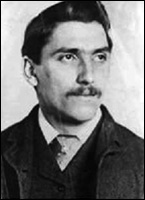 "Inventor" Sebastian de Ferranti (1864–1930). |
|
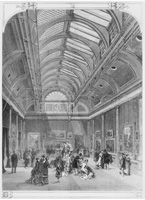 Interior of the Grosvenor Gallery in 1877. |
Ferranti wasted no time in installing Tesla's alternating current system:
In consequence of the growth of the demand from outside consumers, it was decided to establish a permanent generating station on a considerably larger scale, and the construction of this was commenced in December 1884. An excavation 65 ft long by 51 ft wide was made underneath the Gallery for the accommodation of the new machinery, and the boilers were housed in the basement of a new building connected with the engine room by a tunnel about 50 ft. long. (Parsons, The Early Days of the Power Station Industry, pp. 21-22).
Here is another contemporary account of that seminal event:
The alternating current transformer system of supply began to be put into operation first in London in a district round about the Grosvenor Gallery, Bond Street, about 1885, employing transformers in parallel on the house-to-house system as designed by Mr. Ferranti. One objection which had been urged against the alternating current supply in 1883 was that the alternators would not work in parallel. (Fleming, Fifty Years of Electricity; the memories of an electrical engineer, p. 235).
Ferranti was also overseer or chief engineer of the Gallery. Ferranti was indeed an electrical engineer but he was no "inventor" and could only copy the work of Tesla.
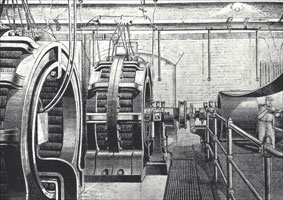 2 massive Tesla alternators were installed by Ferranti in the Grosvenor Gallery. |
|
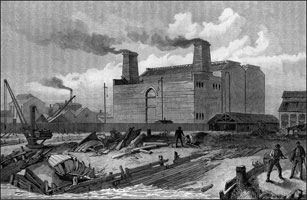 The Deptford Power station was The Deptford Power station was opened in 1889. |
In 1889, a new power station was opened at Deptford, utilizing all of Tesla's alternating current technology. It is regarded at the first central high-voltage power station in the world.
Tesla did not patent his inventions until October 1887
After he quit the Edison company in disgust, Tesla worked for a year as a manual laborer digging trenches for Edison's cables. That was his annus horribilis:
Now came the most unpleasant experience of Tesla's life. He was without a source of income and from the spring of 1886 to the spring of 1887 he was forced to work as a day laborer. "I lived he said through a year of terrible heartaches and bitter tears, my suffering being intensified by material want." (O' Neill, Prodigal Genius: The Life of Nikola Tesla, p. 62).
Eventually, a foreman on the job put him in touch with a Mr. Brown who worked for the Western Union Telegraph Company. Mr. Brown put up some of his own money and Tesla opened the Tesla Electric Company, with a laboratory very close to the Edison Company laboratory.
|
Despite all the attempts of Edison to ruin him, the Creator of electricity was watching over Nikola, and he eventually filed a patent for his inventions:
Tesla sought to obtain a single patent covering the entire system and all of its constituent dynamos, transformers, distribution systems, and motors. His patent attorneys, Duncan, Curtis & Page, filed the application for this patent October 12, 1887, six months after the laboratory opened and five and a half years after Tesla had made his rotary magnetic field invention. (O' Neill, Prodigal Genius: The Life of Nikola Tesla, p. 68).
So staggering and original were the inventions that the Patent Office refused to issue an "omnibus" patent but they insisted that it be broken down into 7 different patents.
Tesla had a very timely death in 1943
Tesla hoped to live way past 100 because his electrotherapy invention kept him youthful and mentally alert even at the age of 87. He was still inventing when he met a very timely death in his hotel room.
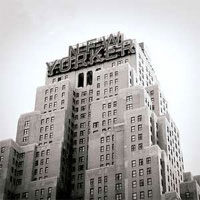 The New Yorker Hotel in 1943. |
|
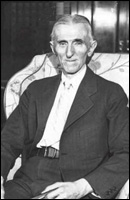 Nikola Tesla in old age. |
The theft of Nikola Tesla's inventions was one of the worst cases of industrial espionage in the entire history of the world.
Vital links
References
